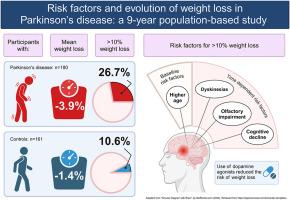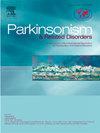Risk factors and evolution of weight loss in Parkinson's disease: A 9-year population-based study
IF 3.1
3区 医学
Q2 CLINICAL NEUROLOGY
引用次数: 0
Abstract
Introduction
Weight loss is considered a common complication of Parkinson's disease (PD), but there are few prospective longitudinal studies on weight loss in patients followed from time of PD diagnosis. We sought to determine the frequency, evolution and risk factors of weight loss in a representative incident PD cohort.
Methods
In this prospective population-based observational study, we followed 180 newly-diagnosed, initially drug-naïve PD patients and 161 controls with repetitive weight examinations over 9 years. We used Cox regression models with adjustment for potential confounders to identify independent risk factors of clinically significant (>10 %) weight loss.
Results
Mean % weight change during follow-up was −3.9 (±11.2) in patients and −1.4 (±8.1) in controls (p = 0.016). Clinically significant weight loss was observed in 26.7 % of patients and 10.6 % of controls (RR 2.53; 95 % CI 1.52–4.21; p < 0.001). Age was the only independent baseline risk factor for weight loss (HR 1.06 per year; 95 % CI 1.03–1.10; p < 0.001). Additional time-dependent risk factors were presence of olfactory impairment (HR 2.42; 95 % CI 1.14–5.15; p = 0.021), presence of dyskinesias (HR 3.14; 95 % CI 1.58–6.23; p = 0.001), and cognitive impairment (HR per MMSE unit 0.90; 95 % CI 0.82–0.99; p = 0.036). Dopamine agonist use reduced the risk of weight loss during follow-up (HR 0.44; 95 % CI 0.24–0.82; p = 0.007).
Conclusion
The risk of weight loss is more than doubled in the general PD population and associated with both disease-related features and drug-related complications. This suggests a multifactorial nature of weight loss in PD, which is important to consider in research and clinical practice.

帕金森病患者体重减轻的风险因素和演变:一项为期 9 年的人群研究
导言:体重减轻被认为是帕金森病(PD)的常见并发症,但很少有关于帕金森病患者体重减轻的前瞻性纵向研究。在这项基于人群的前瞻性观察研究中,我们对 180 名新诊断的、最初未接受过药物治疗的帕金森病患者和 161 名对照组患者进行了长达 9 年的随访,并反复进行了体重检测。结果 随访期间患者的平均体重变化率为-3.9 (±11.2)%,对照组为-1.4 (±8.1)%(p = 0.016)。26.7% 的患者和 10.6% 的对照组出现了临床意义上的体重减轻(RR 2.53; 95 % CI 1.52-4.21; p <0.001)。年龄是体重下降的唯一独立基线风险因素(HR 1.06 per year; 95 % CI 1.03-1.10; p <0.001)。其他随时间变化的风险因素包括嗅觉障碍(HR 2.42;95 % CI 1.14-5.15;p = 0.021)、运动障碍(HR 3.14;95 % CI 1.58-6.23;p = 0.001)和认知障碍(HR 每 MMSE 单位 0.90;95 % CI 0.82-0.99;p = 0.036)。多巴胺受体激动剂的使用降低了随访期间体重下降的风险(HR 0.44;95 % CI 0.24-0.82;p = 0.007)。这表明帕金森病患者体重减轻具有多因素性质,在研究和临床实践中必须加以考虑。
本文章由计算机程序翻译,如有差异,请以英文原文为准。
求助全文
约1分钟内获得全文
求助全文
来源期刊

Parkinsonism & related disorders
医学-临床神经学
CiteScore
6.20
自引率
4.90%
发文量
292
审稿时长
39 days
期刊介绍:
Parkinsonism & Related Disorders publishes the results of basic and clinical research contributing to the understanding, diagnosis and treatment of all neurodegenerative syndromes in which Parkinsonism, Essential Tremor or related movement disorders may be a feature. Regular features will include: Review Articles, Point of View articles, Full-length Articles, Short Communications, Case Reports and Letter to the Editor.
 求助内容:
求助内容: 应助结果提醒方式:
应助结果提醒方式:


